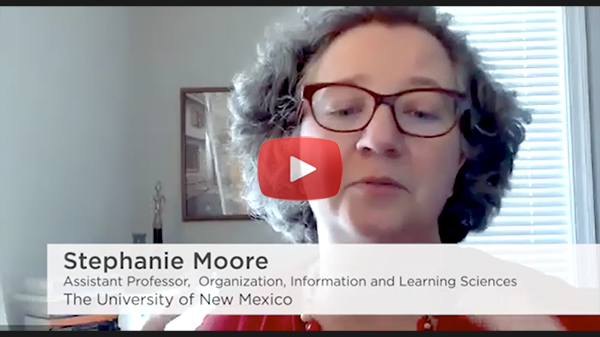Bringing TOPkit Digest to You
|
|
|
The content in this month’s TOPkit Digest is brought to you by Florence Williams, Ph.D., Associate Instructional Designer, Center for Distributed Learning, University of Central Florida (Florence.Williams@ucf.edu) who discusses the topic of flexible course design policies and practice.
|
|
Contents of this Digest:
- Video Tip: Insights on Designing Flexible Courses
- Top Tips: Flexible Course Design Policies and Practice
- Must-Read Announcements: TOPkit Workshop, Innovation Summit
- From the Community: Tools, Techniques, & Strategies
- Ask ADDIE: Essential Work or Essential Workers: Who Can Tell?
- Top Community Topics
|
|
Insights on Designing Flexible Courses
Perspectives for Effective Student Engagement |
|
|
|
In this video, Dr. Stephanie Moore, Assistant Professor of Organization, Information and Learning Science at the University of New Mexico, offers some tips for effective course design to move the paradigm from teacher-led instruction to more significant opportunities for learner flexibility and collaboration. Moore discusses a design shift that focuses on hi-flex modalities to support student engagement and collaboration and strengthen student autonomy. |
|
Flexible Course Design Policies and Practice
Engendering Learner Engagement with Flexible Design Principles |
|
|
|
Flexible course design gives learners the freedom to select learning content, pathways, and timing. The design intentionally creates opportunities for optimal classroom engagement and educational benefit. The flexible design approach is time and location agnostic, thus minimizing the administrative burden for faculty and alleviating learner anxiety. Learning architects can modify the design to offer content and assessment options to meet curriculum and learner needs. A flexible approach aims to achieve dynamic social processes that encourage community development and learner success. Several key dimensions of a flexible approach are explored in the tips below:
|
|
|
|
|
|
|
|
|
#1 - Design for compassionate pedagogy. Even before the Coronavirus pandemic, building an alignment between effective teaching and compassionate teaching has been at the forefront of instructional design. The pandemic accelerated stressful settings and unfamiliar circumstances which forced adaptation as no single situation had done in our memory. These adaptations will permeate course design practices as institutions return to normalcy. Intentionally acknowledging stress, building in flexibility, and creating a culture of communication are strategies for compassionate pedagogy offered by Schacter, Brown, Daugherty, Brummelte & Grekin (2021).
|
|
#2 - Make effective practices integral to the design approach. Effective course design aligns with good planning and organization. Planning supports sustained faculty and learner engagement and underscores content presentation. Universal Design for Learning (UDL) principles encourage interaction and a range of content options for easy display in user devices. It is also helpful to integrate active learning principles by incorporating practice and knowledge checking opportunities. (Williams, 2021)
|
|
#3 - Incorporate innovative and interactive content. Create content that supports learner interaction and control. Integrate a mix of traditional and non-traditional learning resources, like text, audio, graphics, multimedia, and video for individual and collaborative engagement. Tap into learner interest by incorporating gamification and innovative tools and technology. Support learner control with multi-device compatible media with learner manipulated volume and speed. Consider and reduce potential barriers to accessibility in the design by thinking about color contrast, text density and reading rate. | |
#4 - Strive for diversity when inviting faculty to participate. It is essential to ask big questions in course design: Who are the stakeholders, and what do they want from the engagement? Faculty administrators, instructional design staff, and faculty often share student recruitment and retention capital. Finding ways to ignite the minds of our joint investment, the learner, is implicit in Carnes's (2018) Minds on Fire. The narrative provides practical design principles to address the questions using role-immersion games, "Reacting to the Past" pedagogy to channel students' impulses into transformative learning experiences.
|
|
#5 - Set the right tone. The advanced pedagogy approach can enhance course design and encourage learner performance. Introductory faculty development courses help faculty with the fundamentals for preparing online courses. Kemery and Williams (2021) introduce a progressive pedagogical approach that builds upon the foundation by including innovative strategies and tools that take design into the digital domain for online learning. Faculty and instructional designers collaborate to form coalitions that make design and subject matter expertise lifelong partners.
|
|
Tools, Techniques, & Strategies for Faculty Developers and Instructional Designers
Online Best Practices that Work |
|
|
|
 | |
Online education has continued to evolve. With its evolution, instructional designers must identify instructive best practices for online delivery as they work with new and veteran online faculty. Flexible course design creates transparent patterns for course design and creates pathways for effective teaching and learning. Williams’ review of effective practices includes designing for student engagement, and increased faculty buy-in for faculty development including resources for content support and content stability.
|
|
Essential Work or Essential Workers
|
|
|
|
| |
 |
Dear ADDIE, The U.S. Department of Education (DOE) now requires that all online courses for which students may use Title IV funds (federal financial aid) include regular and substantive interaction (RSI) between students and instructors. There must be “scheduled and predictable” opportunities for instructor/student interaction in course design. As proponents of online learning design, my colleagues and I thought that we could work with any policy requirement for student access, accessibility, or interaction by leveraging innovation and delivery with design thinking. However, this need to address instructor/student interaction through course design, and the related guidance for implementation are new. Putting it bluntly, we’re stumped! Should we include the RSI in course-design consultations or share the requirement as a quality item and leave it to the faculty to create these opportunities through course facilitation? Signed, Stumped Proponent
|
|
References and Works Consulted
|
|
|
Carnes, M. (2018). Minds on fire: How role immersion games transform college. Cambridge: Harvard University Press. Kelly, K & Zakrajsek. (2020). Advancing Online Teaching: Creating equity-based digital learning environments. Cambridge: Stylus Publishing. Kemery, D., & Williams, F. (2021). Course planning for advanced online pedagogy. Orlando: TOPkit Fall Hackathon 2021: Teaching Online Preparation Toolkit. https://topkit.org/hackathon/ Moore, S. (2021, March 17). Insights on Designing Flexible Courses. EDUCAUSE contributor University of New Mexico, New Mexico, United States. Retrieved from https://youtu.be/MOxdqIcFlTg Schacter, H. L., Brown, S. G., Daugherty, A. M., & Grekin, S. B. (2021, December 1). Creating a Compassionate Classroom. Retrieved from Inside Higher Ed: https://www.insidehighered.com/advice/2021/12/01/compassionate-teaching-yields-most-benefits-opinion#.YagpBtiiwtg. Williams, F. (2021, October 1). Online Best Practices that Work. Retrieved from TOPkit: Teaching Online Preparation Toolkit: https://topkit.org/developing/tools-techniques-strategies/online-best-practices-that-work/
|
|
Developer and Editor
Bren Bedford, MNM, Web Project Analyst, Center for Distributed Learning, University of Central Florida
Editor
Denise Lowe, Ed.D., Organizational Leadership - Higher Education, Senior Instructional Designer, Center for Distributed Learning, University of Central Florida
|
|
|



